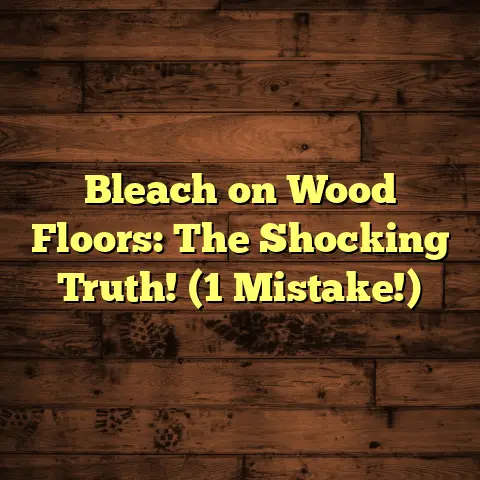Commercial Kitchen Flooring Types? (3 Code Violations!)
Warning: Before you embark on your journey to select the
appropriate flooring for your commercial kitchen, be aware
that the choices you make can have significant implications
for safety, hygiene, and compliance with local health codes.
Ignoring these factors may lead to costly renovations, fines,
or even the closure of your establishment.
Always prioritize
a thorough understanding of the regulations that govern
your industry.
Introduction:
Think about it: Your kitchen floor takes a beating.
Heavy
foot traffic, dropped pots, spills galore – it’s a battlefield
down there.
It needs to withstand all that while also being
easy to clean and slip-resistant.
And if you mess up the
flooring choice, you could be looking at some serious code
violations, which can lead to hefty fines or even getting
shut down.
I’ve seen it happen, and it’s not pretty.
So, let’s dive into the world of commercial kitchen flooring, explore the different types, and, most importantly, talk about those dreaded code violations you need to avoid.
Section 1: Overview of Commercial Kitchen Flooring Types
Okay, let’s get down to the nitty-gritty.
There are several
flooring options out there for commercial kitchens, each
with its own set of pros and cons.
I’ll walk you through
some of the most common ones:
1.1 Vinyl Flooring
Description:
Vinyl flooring is a popular choice for commercial kitchens,
and for good reason.
It’s durable, relatively inexpensive,
and easy to maintain.
Plus, it comes in a wide variety of
styles and colors, so you can find something that fits your
kitchen’s aesthetic.
Pros and Cons:
Pros:
- Water-resistant: This is huge in a kitchen where spills are inevitable.
- Cost-effective: It won’t break the bank, which is always a plus.
- Easy to clean: A quick mop is usually all it takes.
- Variety of styles: You can find vinyl that looks like wood, tile, or even stone.
- Water-resistant: This is huge in a kitchen where spills are inevitable.
Cons:
- Potential for scratches: It’s not as tough as some other options, so it can scratch or dent if you’re not careful.
- Can be slippery when wet: Choose a textured vinyl to avoid this.
- Not as heat-resistant as some other options: Avoid placing hot pots and pans directly on the vinyl.
- Potential for scratches: It’s not as tough as some other options, so it can scratch or dent if you’re not careful.
Code Compliance:
Vinyl flooring can definitely meet health codes when
installed correctly.
The key is to make sure it’s properly
sealed to prevent water from seeping underneath.
Also,
choose a vinyl with a slip-resistant surface to avoid
accidents.
1.2 Tile Flooring
Description:
Tile flooring, particularly ceramic and porcelain tiles,
is another popular option for commercial kitchens.
It’s
known for its durability and aesthetic appeal.
Pros and Cons:
Pros:
- Resistant to heat and stains: This is a big plus in a kitchen environment.
- Durable: Tile can withstand heavy foot traffic and equipment.
- Aesthetic appeal: Tile can add a touch of elegance to your kitchen.
- Water resistant: If it’s glazed and properly sealed.
- Resistant to heat and stains: This is a big plus in a kitchen environment.
Cons:
- Potential for cracking: Especially if something heavy is dropped on it.
- Grout maintenance: Grout can be a pain to keep clean and can harbor bacteria if not properly maintained.
- Hard and unforgiving: Standing on tile for long periods can be tiring.
- Potential for cracking: Especially if something heavy is dropped on it.
Code Compliance:
Tile flooring can comply with health and safety standards
if properly installed and maintained.
Make sure the grout
is sealed to prevent water and bacteria from penetrating.
Also, choose a tile with a textured surface to prevent
slips.
1.3 Epoxy Flooring
Description:
Epoxy flooring is a seamless, durable, and chemical-resistant option that’s becoming increasingly popular in commercial kitchens.
Pros and Cons:
Pros:
- Seamless application: This eliminates cracks and crevices where bacteria can hide.
- Chemical resistance: It can withstand spills of grease, oil, and other kitchen chemicals.
- Ease of cleaning: A quick mop is usually all it takes.
- Customizable: You can choose from a variety of colors and finishes.
- Seamless application: This eliminates cracks and crevices where bacteria can hide.
Cons:
- Installation time: Epoxy flooring can take several days to install.
- Can be slippery when wet: Additives can be added to make it slip-resistant.
- Cost: Epoxy flooring can be more expensive than some other options.
- Installation time: Epoxy flooring can take several days to install.
Code Compliance:
Epoxy flooring is a great choice for high-traffic and
spill-prone areas because it is seamless and easy to clean.
It’s also resistant to bacteria and mold growth, which
helps with code adherence.
1.4 Concrete Flooring
Description:
Polished and sealed concrete is another option for
commercial kitchens.
It’s known for its longevity and
industrial look.
Pros and Cons:
Pros:
- Longevity: Concrete can last for decades with proper maintenance.
- Cost-effective: Concrete can be less expensive than some other options, especially if you already have a concrete slab.
- Industrial look: Some people like the raw, industrial aesthetic of concrete.
- Longevity: Concrete can last for decades with proper maintenance.
Cons:
- Slipperiness: Concrete can be very slippery when wet, which is a major safety hazard in a kitchen.
- Porous: Concrete is naturally porous, so it needs to be sealed to prevent water and bacteria from penetrating.
- Hard and unforgiving: Standing on concrete for long periods can be tiring.
- Slipperiness: Concrete can be very slippery when wet, which is a major safety hazard in a kitchen.
Code Compliance:
Concrete can meet or violate health codes depending on
how it’s treated.
If it’s not properly sealed, it can
harbor bacteria and become a breeding ground for mold.
Also, the slipperiness of concrete is a major safety
concern.
1.5 Rubber Flooring
Description:
Rubber flooring is a slip-resistant and comfortable option for commercial kitchens.
Pros and Cons:
Pros:
- Slip resistance: This is a major safety benefit in a kitchen.
- Comfort underfoot: Rubber flooring is more comfortable to stand on than concrete or tile.
- Shock absorption: This can help reduce fatigue and prevent injuries.
- Slip resistance: This is a major safety benefit in a kitchen.
Cons:
- Potential for wear over time: Rubber flooring can wear down over time, especially in high-traffic areas.
- Not as aesthetically pleasing as some other options: Rubber flooring doesn’t have the same visual appeal as tile or polished concrete.
- Can be damaged by grease and oil: It needs to be properly maintained and cleaned.
- Potential for wear over time: Rubber flooring can wear down over time, especially in high-traffic areas.
Code Compliance:
Rubber flooring can comply with regulations because of its
slip-resistant properties.
However, issues may arise if
it’s not properly maintained and cleaned, as it can be
damaged by grease and oil.
Section 2: The Importance of Code Compliance in Flooring Selection
Alright, now let’s talk about the elephant in the room:
code compliance.
Choosing the right flooring isn’t just
about aesthetics and durability; it’s also about making
sure you’re following the rules and regulations set by
your local health department.
2.1 Understanding Code Violations
So, what exactly constitutes a code violation in the
context of commercial kitchen flooring?
Well, it’s any
deviation from the standards set by your local health
department.
These standards are in place to protect
the health and safety of your employees and customers.
The potential consequences of non-compliance can be
severe.
You could face fines, which can range from a
few hundred dollars to thousands of dollars.
You could
also be forced to shut down your kitchen until you fix
the violations.
And in the worst-case scenario, you
could be held liable for any injuries or illnesses that
result from your non-compliance.
2.2 The Three Key Code Violations
Okay, let’s get specific.
Here are three of the most
common code violations related to commercial kitchen
flooring:
Violation 1: Improper Drainage
Flooring that doesn’t allow for proper drainage can lead
to water accumulation and mold growth.
This is a major
health hazard, as mold can cause respiratory problems
and other health issues.
Think about it: When you’re washing dishes, cleaning
equipment, or mopping the floor, water is going to spill.
If that water can’t drain properly, it’s going to pool up
on the floor, creating a breeding ground for bacteria and
mold.
To avoid this violation, make sure your flooring is
sloped towards a drain.
Also, make sure the drains are
clear and functioning properly.
Violation 2: Inappropriate Material Use
Using materials that are not non-porous or easy to clean
can result in hygiene issues.
Porous materials can absorb
spills and bacteria, making them difficult to clean and
sanitize.
For example, untreated wood or carpet would be a terrible
choice for a commercial kitchen floor.
These materials
are highly porous and can quickly become contaminated
with bacteria and mold.
To avoid this violation, choose flooring materials that are non-porous and easy to clean, such as vinyl, tile, epoxy, or sealed concrete.
Violation 3: Slippery Surfaces
Selecting flooring that becomes dangerously slippery when
wet can lead to accidents and liability issues.
Slips and
falls are a leading cause of injuries in commercial
kitchens.
Imagine a busy kitchen during the dinner rush.
Employees
are rushing around, carrying hot food and heavy equipment.
If the floor is slippery, it’s only a matter of time before
someone falls and gets hurt.
To avoid this violation, choose flooring with a slip-
resistant surface.
This could be textured vinyl, tile with
a slip-resistant coating, or rubber flooring.
According to the CDC, each year, more than 800,000
Americans are hospitalized because of a fall injury.
Also,
falls are the most common cause of traumatic brain
injuries (TBI).
[https://www.cdc.gov/falls/index.html]
Section 3: Case Studies of Code Violations and Their Consequences
Let me share a couple of real-life examples of establishments that ran into trouble because of their flooring choices:
Case Study 1: The Greasy Spoon Diner
The Greasy Spoon Diner was a local favorite known for
its hearty breakfasts and friendly service.
However, the
diner’s flooring was a disaster waiting to happen.
They
had installed cheap, unsealed tile in the kitchen, and
the grout was cracked and stained.
During a routine health inspection, the inspector found
that the grout was harboring bacteria and mold.
The diner
was cited for multiple code violations and given a week
to fix the problem.
The owner of the Greasy Spoon was forced to shut down
the diner for several days while they ripped out the old
tile and installed new, sealed tile.
The renovation cost
them thousands of dollars in lost revenue and repair costs.
Case Study 2: The Upscale Bistro
The Upscale Bistro was a trendy restaurant known for its
modern decor and innovative cuisine.
However, the bistro
made a major mistake when they chose their flooring.
They
installed polished concrete in the kitchen, which looked
great but was incredibly slippery when wet.
One day, a server slipped and fell in the kitchen,
sustaining a serious head injury.
The server sued the
bistro for negligence, and the bistro was forced to pay
a large settlement.
The bistro was also cited for code violations and ordered
to install slip-resistant flooring.
They ended up having
to cover the concrete with rubber flooring, which ruined
the aesthetic of the kitchen.
These case studies illustrate the importance of choosing
the right flooring for your commercial kitchen.
Don’t
make the same mistakes these establishments did.
Conclusion:
So, there you have it.
We’ve covered a lot of ground,
from the different types of commercial kitchen flooring
to the potential code violations you need to avoid.
Remember, choosing the right flooring is a critical
decision that can impact the safety, hygiene, and
longevity of your kitchen.
Don’t cut corners or make
decisions based solely on aesthetics.
Take the time to research your options, understand the
code requirements, and choose flooring that meets your
specific needs.
It’s an investment that will pay off in
the long run.
And if you’re not sure where to start, don’t hesitate to
consult with a qualified flooring contractor.
We can help
you navigate the complex world of commercial kitchen
flooring and ensure that you make the right choice for
your business.
Good luck!





